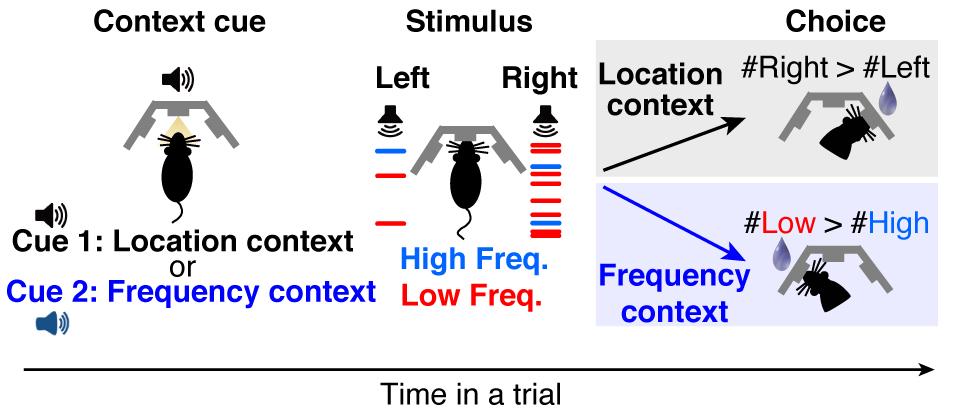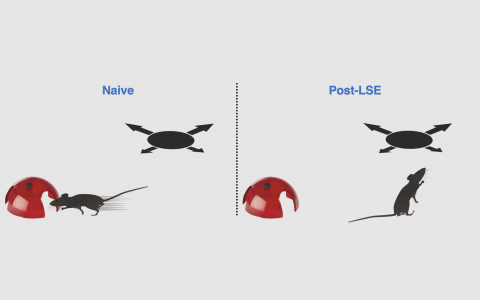
Exploring individual variability in cognitive behaviour
An interview with Dr Marino Pagan, University of Edinburgh, conducted by April Cashin-Garbutt
Have you ever wondered how your brain adapts to different situations, such as driving on the left or right side of the road depending on the country you are in? Do our brains solve these context-dependent tasks in the same way or is there individual variability?
Dr Marino Pagan is a principal investigator at the Simons Initiative for the Developing Brain (SIDB) at the University of Edinburgh. He recently gave a seminar at SWC on his work uncovering the neural sources of individual variability in cognitive behaviour. In this Q&A he explains his key findings and his mission to understand how these brain circuits are altered in neurodevelopmental disorders that affect cognitive flexibility including autism spectrum disorder (ASD), attention-deficit hyperactivity disorder (ADHD) and schizophrenia.
Why is cognitive flexibility so important?
A lot of the decisions and actions that we perform every day are not simply based on the stimuli in front of us, they are strongly dependent on context. We need to adapt to the situation we are in. For example, imagine your phone rings. If you’re waiting for an important call, you should immediately pick it up; but if you are in a movie theatre, then you should immediately silence your phone to avoid disturbing everyone.
There are lots of situations like this where the way we respond to the stimuli around us depends on the context. It is a key ability to be able to adapt our actions and decisions to the context we are in and rapidly switch the moment the context switches. The inability to adapt can create big issues and is affected in some neurodevelopmental disorders.

Is it challenging training animals to perform tasks requiring context-dependent evidence?
Yes, it is extremely challenging! The main reason is that you want them to apply specific context-depending rules, but you can’t talk to them and tell them what the rules are and what they’re supposed to do. All they can do is try and if they get it right, we give them a reward; if they get it wrong, they don’t get a reward. So it is only by trial and error that they can build their understanding of what they’re supposed to be doing and what we want them to do. All the while, we have to keep them motivated and interested enough so that they don’t get frustrated and think it is not worth trying.
The way we train them is called the staircase procedure. We build the blocks of the task from simpler elements onto more complex elements, always making it understandable for the animal. Very gradually we can build on these simple tasks by adding more complex rules.
Why did you decide to work on a context-dependent decision-making task in animals?
I decided to work on this task, not because it was easy to train animals on it, but because it allows me to study this very important cognitive ability, cognitive flexibility, and because it is a highly controlled behaviour that provides me with the very precise ability to measure the behaviour of the subjects and their neural activity.
There is a lot of information that can be derived from the complex stimuli that I use and that allows me to very precisely characterise exactly what aspects of the stimuli the animals are using in making their choices as well as what aspects of the stimuli the neurons are responding to. This kind of precision is necessary to then fit the computational models that I use.
How did you develop a high-throughput training system?
I am extremely grateful to my postdoctoral advisor, Carlos Brody, because he is the one that first had the vision. If we’re trying to train rats to do very hard tasks, and it takes a long time to train each individual animal, training them in parallel through a high-throughput procedure allows us to train many of them in a relatively short time.
Carlos developed a system including general purpose software that allows researchers to implement many different tasks. Many of the researchers at SWC, who used to be in the Brody lab, have exported this model in the context of their tasks.
What I did, was to take of advantage of this system, and adapt the software to implement this context-dependent decision-making task. I created an automated training procedure so that, within this high-throughput system, the rats can learn to perform this task automatically.
Essentially, I am standing on the shoulder of giants to adapt this system to be compatible with this specific task.

What have been your key findings so far? Were you surprised by them?
The key finding is the presence of individual variability. When I analysed the behaviour of the animals and the neural data, the dynamics I obtained differed between individuals. This was very unexpected to us. I remember when I first saw the curves, I thought we must have done something wrong!
After a while, we realised this was true and that not all animals solve the task in the same way. Even if on the surface it may look like two different animals are performing the same task, inside the mechanism might not be the same.
I think this is something that is underappreciated, partly because it has been very hard to probe this kind of individual variability. Usually in difficult tasks, we only record what is common across animals and differences get discarded.
Do individual animals vary across sessions?
To the degree that I have looked at it, the answer is no. These different dynamics were consistent within an animal across the sessions. However, it is hard to state definitively that is does not occur at all.
The analysis that I am doing requires a lot of data so you can’t do it for a session alone because you don’t have enough data. You need to put many sessions together and use that big chunk of data. However, you can do things like splitting sessions in half and look if the two halves match. This turned out to be the case for my analysis.
Does your research have implications for neurodevelopmental disorders?
Yes! My current lab is within the SIDB at the University of Edinburgh. One of the main goals of SIDB is to use state of the art approaches to understand the neural mechanisms linking genetic mutations to cognitive and neurodevelopmental disorders. What I’m really excited to be doing is to use these behavioural paradigms in the context of rat models of genetic disorders, which have recently been developed here at SIDB.
The reason why this is important is that cognitive flexibility is highly affected in many neurodevelopmental disorders including ASD, ADHD and schizophrenia. We know very little about why this fundamental cognitive skill is impacted in these disorders.
We have made so much progress about the genes that cause these disorders and there are big genome-wide association studies (GWAS) where a lot of genes have been tagged as having very high risk for autism, or ADHD or schizophrenia, if they are mutated. A lot of work has also gone into what proteins these genes encode and what functions those proteins serve.
At the level of cellular and molecular neuroscience, there is a wealth of information, but at the systems level, the knowledge is lacking. For example, we don’t know why if you tinker with the gene for a certain ion channel, the whole circuit that does decision-making stops working. We are only just starting to look at animal models that allow us to probe the sophisticated behaviours and cognitive deficits.
The goal of my research is to use rat models of genetic disorders, that have only recently been developed, and to use this very sophisticated task to precisely characterise cognitive deficits for different genetic mutations and understand how the circuits are altered. This will allow us to get an understanding at the level of systems and computation and try to link the cognitive dysfunction with the genetic and molecular alteration.
What’s the next piece of the puzzle your research is going to focus on?
There is a lot of work still to be done in understanding the mechanisms. This can be done in wildtype animals because it is really hard to understand how the circuits are altered by genetic mutations, if you don’t know what the circuits are in the first place.
There are two parallel sides to my research. One is to keep understanding in as much detail as possible at the level of the individual animals what are the circuits that underlie this kind of cognitive flexibility. The other side is to look at genetic mutations one at a time and see how these genetic mutations alter the circuits. The ultimate goal is what can we do to potentially treat these alterations.

About Dr Pagan
Marino Pagan is a principal investigator at the Simons Initiative for the Developing Brain at the University of Edinburgh. He received his B.S. in Computer Engineering and his M.S. in Control Engineering from Scuola Superiore Sant’Anna and University of Pisa in Italy. He completed his Ph.D. in Neuroscience at University of Pennsylvania in the laboratory of Nicole Rust, where he studied the neural substrates of visual object search in macaque monkeys using electrophysiology and computational modelling. In his postdoctoral research with Carlos Brody at Princeton University, Pagan studied the neural mechanisms underlying cognitive flexibility in rats performing complex rule-switching tasks. With the support of a SFARI Bridge to Independence Fellowship, Pagan aims to investigate the neural circuits underlying flexible decision-making, and how these circuits are altered by genetic mutations implicated in neurodevelopmental disorders.


